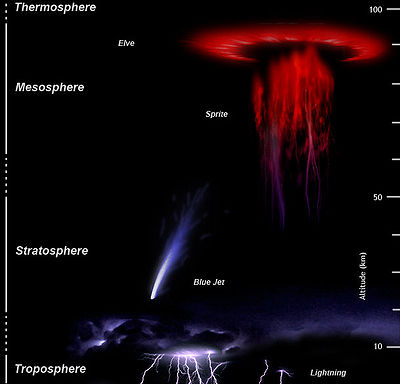Ever heard of lightning’s stranger cousins—red sprites, blue jets, elves, trolls, and gnomes? No, these brilliant lights are not fairy tales; they are a colorful community of lightning flashes that occur high above thunderstorm clouds. Find out what causes this phenomonon and how to see a lightning sprite!
For over a century, these flashes of lightning that shot up from storm clouds, like stories of rains of toads, were dismissed as fiction. Sporadic visual reports of sprites go back at least to 1886. Even when respectable pilots or scientists (including CTR Wilson, a Nobel Prize winning physicist) described them, the scientific community ignored the events. Then, in 1989, something awkward happened. The scientists from the University of Minnesota actually caught the so-called “sprites” on film; since then, they’ve been subsequently been captured in photographs and video recordings many thousands of times
Oops!
Since then, scientists have been studying not just the lightning that crashes down from thunderstorms, but also these colorful flashes that stream up towards space. Electricity soars up to the electrically charged ionosphere, just as it plunges down towards the earth.
What are Sprites and TLEs?
Together, these flashy events are labeled Transient Luminous Events or TLEs. Individual light flashes have much more playful names. The original lights were named sprites because they were mysterious, the other lights received fairy names because scientists can have a sense of humor.
Sprites or red sprites are large-scale electrical discharges that occur high above thunderstorm clouds, or cumulonimbus, giving rise to a quite varied range of visual shapes flickering in the night sky. They are usually triggered by the discharges of positive lightning between an underlying thundercloud and the ground.
Different TLEs flash at different levels in the sky. SOURCE: Wikipedia
So, if you look high in the sky, well above over the thunderstorms, what can you see?
- Sprites—The most common TLE is a luminous reddish-orange flash directly above large thunderstorms. Sprites flash a fraction of a second after strong lightning strokes, soaring up almost 60 miles high. They often occur in clusters above the troposphere and most frequently seen in the Midwest.
- Blue Jets—A blue jet is a dim blue light that rises like a quick puff of smoke above heavy hailstorms. They are quite rare and usually can only be seen from airplanes.
- Elves—Elves are brief disks of dim light that appear around 60 miles high in the atmosphere. Actually, the name is an abbreviation of the disk’s real name—Emissions of Light and Very low frequency from EMP Sources.
- Trolls—These red spots pop near cloud tops after the flash of an extremely strong red sprite. Like Elves, Trolls are an abbreviation: Transient Red Optical Luminous Lineament.
- Gnomes—The tiniest and quickest flashes are gnomes. They are small white spikes of light that flash for a microsecond from the top of a large thundercloud’s anvil.

Image: Look over the top of thunderstorms to see sprites and other flashes. NASA.
Here’s an interesting fact: Lightning sprites and TLEs do not happen in our normal thunderstorms with rain clouds. All of Earth weather occurs in the troposphere (4 to 12 miles above us). Rather, these flashes happen in the Earth’s mesosphere, up to 50 miles high in the sky.
How to See a Red Sprite
A red sprite is the easiest TLE to see. They aren’t actually rare but they’re just not commonly seen because no one’s looking for them!
- You need big thunderstorms, which are more common during spring and summer. June is the peak month for these sort of storms, but sprites can happen any time during a strong storms with intense lightning at ground level.
- The thunderstorms needs to during the nighttime. Of course, the skies need to be very dark and clear. There can’t be much light pollution which would wash out sprites. Avoid bright moonlight.
- The storm should be in the distance (100 to 200 miles away), so clouds do not block the sky and you have an unobstructed view. Ideally, the storm is moving out of the region or along a distant horizon so that you can see above the cloud tops. Use weather radar to track a storm.
- Give your eyes 20 minutes to adapt to darkness. And then try to keep your eyes above the clouds (not on the clouds) while ignoring the lightning flashes. Sprites pop into view roughly once for every 200 lightning strokes.
Note: It may be difficult to capture a sprite on camera as the flash is fleeting.
Watch this gorgeous video by Paul M Smith which shows Red Sprite lightning from the 2019 storm season in Oklahoma.
Next time you see a thunderstorm, look above it. You may see a fairyland!



